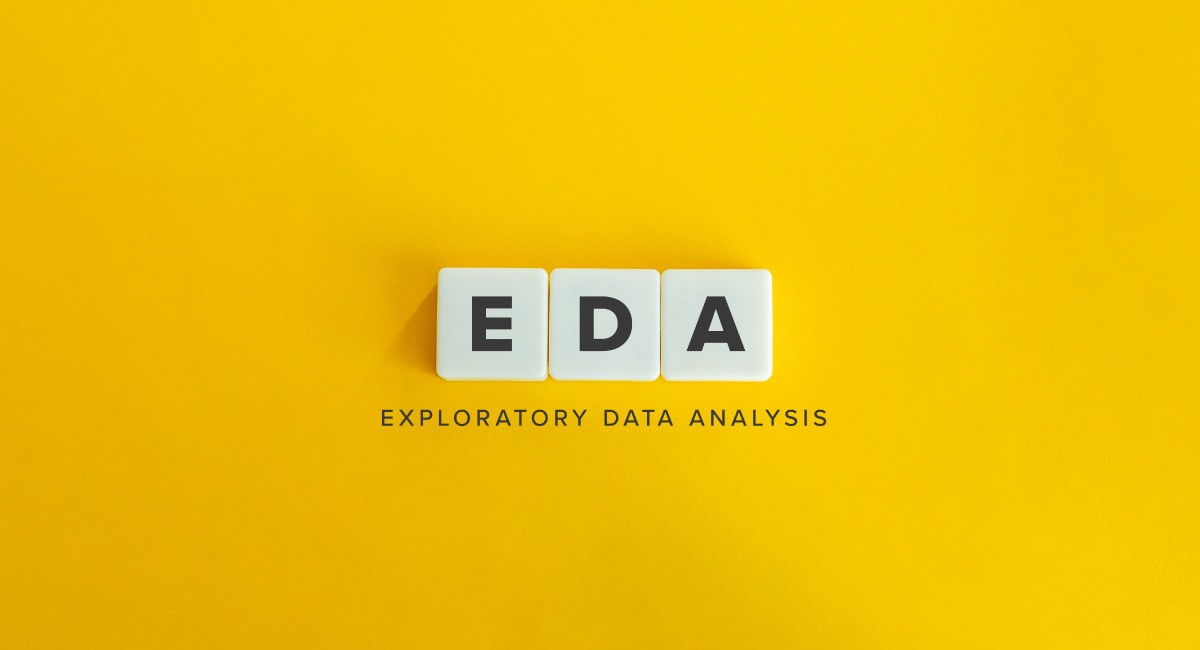We live and work in a data-driven society. Success in today’s Information Age obliges us to extract as much relevance and leverage as possible from the vast available data sets. Given the sheer volume of information, this can be a daunting task. Fortunately, tools such as exploratory data analysis (EDA) make the process easier and more effective.
This article answers the question, “What is exploratory data analysis?” We will investigate its importance and role in data science, various types, tools, and more. We’ll also share an online data science program professionals can take to boost their skills.
Let’s begin our journey with a definition. What is EDA?
What is EDA?
Exploratory data analysis is a process of data analytics used to understand data in depth and learn its different characteristics, typically with visual means. This process lets analysts get a better feel for the data and helps them find functional patterns.
EDA primarily uses machine learning and deep learning models to discover what the data can show beyond the formal modeling or hypothesis training tasks. EDA gives data scientists a better understanding of data set variables and their relationships.
Now, let’s see what kinds of exploratory data analysis are available.
Also Read: Why Use Python for Data Science?
The Types of Exploratory Data Analysis
There are four chief types of EDA.
Univariate Non-Graphical
Univariate non-graphical EDA is the most straightforward form of data analysis. It analyzes data consisting of just one variable. Because it’s a single variable, this type of EDA doesn’t deal with causes or relationships. The chief purpose of univariate analysis is to describe the data and notice patterns within it.
Univariate Graphical
Since non-graphical EDA methods don’t offer a complete picture of the data, data analysts must sometimes turn to graphical methods. Univariate graphical EDAs are typically sub-divided into the following forms:
- Box plots, which graphically show the analyst the five-number summaries of minimum, first quartile, median, third quartile, and maximum
- Stem-and-leaf plots that show all the data values and the distribution’s shape
- Histograms are bar plots in which each bar represents the frequency, also called the count or proportion of count to the total count, of cases for a range of values.
Multivariate Nongraphical
Multivariate data originates from more than one variable. Common multivariate non-graphical EDA techniques show the relationship between two or more data variables via cross-tabulation or statistics.
Multivariate Graphical
Multivariate graphical data uses graphics to illustrate the relationships between two or more data sets. The most used graphic in this form of EDA is a grouped bar plot or bar chart, each group representing a single level of one of the variables and each bar within the group representing levels of the other variable.
There are forms of multivariate graphics, including:
- Bubble charts are a form of data visualization that employs multiple circles (or bubbles) in a two-dimensional plot
- Heat maps are graphical data representations where colors show values
- Multivariate charts are graphical representations of the relationships between factors and a response
- Run charts are line graphs of data plotted over time
- Scatter plots are used to plot data points on horizontal and vertical axes to demonstrate how much one variable is affected by another
Now, let’s see why exploratory data analysis is so vital to the data analysis process.
Why is Exploratory Data Analysis Important?
Over the past decade, the data science field has proven its value and importance in the business world by providing vast opportunities for organizations to make critical business decisions by analyzing massive data streams. This data must be explored from every aspect to understand it more thoroughly, and that’s where exploratory data analysis comes in. EDA’s impactful features allow data analysts and researchers to make meaningful and productive decisions. Hence, EDA has an invaluable place in the field of data science.
Additionally, exploratory data analysis proves its worth by:
- Helping analysts prepare their data sets for analysis
- Allowing machine learning models to predict data sets better
- Giving researchers more accurate results
- Helping analysts choose a better machine learning model
Also Read: A Beginner’s Guide to the Data Science Process
What Are the Objectives of EDA?
Exploratory data analysis is designed to gather vital insights, typically via these further breakdowns:
- Identify and remove data outliers
- Identify trends in time and space
- Identify new data sources
- Create and test hypotheses experiments
- Uncover patterns that relate to the target
The Role of EDA in Data Science
EDA’s role is based on the objectives achieved in the previous section. After data gets formatted, the analysis performed shows patterns and trends that eventually help the organization take the necessary actions to meet the business’s expected goals. Since any executive or manager may perform specific tasks in any given position, the appropriate EDA measures are expected to answer any questions related to a particular business decision comprehensively.
Data science involves building models to make predictions; thus, the models need optimum data features. Consequently, EDA ensures that the correct elements in patterns and trends are available to train the model to achieve the correct outcome. So, carrying out a suitable EDA with the appropriate tool based on the data that befits the expected goal helps achieve the expected goal.
Now that we’ve established how necessary and significant EDA is, let’s review the steps to conduct it successfully.
The Steps Used in Exploratory Data Analysis
- Collecting the Data. These days, data about every aspect of human life, such as commerce, healthcare, sports, manufacturing, leisure, and many more, is created in vast quantities and diverse forms. Every organization knows how essential it is to use this data beneficially by adequately analyzing it. However, this process hinges on collecting appropriate data from disparate sources via surveys, social media interactions, and customer reviews. Further, EDA actions cannot be taken without sufficient and appropriate data.
- Finding All Variables and Understanding Them. When the analysis begins, the initial focus is on the available data, which provides much relevant information. This information holds changing values that describe various features or characteristics, which then helps the data analyst understand and gather valuable insights from them. However, the analyst must first identify the critical variables affecting the outcome and their possible impact. This step is vital for obtaining the analysis’s ultimate results.
- Cleaning the Data Set. The next step is cleaning the data set, which could contain null values or irrelevant information. These anomalies must be removed so the data contains only the essential relevant values from the target’s point of view. This cleaning process will reduce time and lessen the required computational power. Preprocessing addresses all issues, such as finding null values, outliers, anomaly detection, etc.
- Identifying Correlated Variables. Finding a correlation between variables helps analysts understand how a particular variable relates to another. The correlation matrix method provides a clear picture of how the different variables correlate, which further helps to understand the important relationships between them.
- Choosing the Appropriate Statistical Methods. Different statistical tools are used depending on the categorical or numerical data, its size, the type of variables, and the purpose of analysis. Statistical formulae for numerical outputs provide decent information, but graphic-based visuals are more pleasing and more accessible to interpret.
- Visualizing and Analyzing Results. Once the analysis is finished, the findings must be reviewed meticulously and thoroughly so people can interpret them correctly. The data spread trends and the correlation between the variables offer solid insights for making the best changes to the data parameters. The data analyst should have the necessary capabilities to analyze data and be well-versed in various analysis techniques.
Also Read: What Is Data Mining? A Beginner’s Guide
The Questions You Should Ask When Conducting Exploratory Data Analysis
Here are the 15 essential questions you should ask when using EDA.
- What are the essential characteristics of the data set?
- What is the overall structure of the data set?
- What patterns exist in the data?
- Are there any outliers present?
- What are the data set’s missing values?
- How correct is the data? Is it from an authentic source, does it contain duplicate values, etc.?
- Is there any correlation between the variables?
- How does this data compare to past performance?
- Is there any seasonality?
- How much variability exists in each variable?
- Do any discrepancies exist between the observed values and expected values?
- What are some possible explanations for unexpected results?
- How do different subsets of the data set behave differently?
- Do you need to transform any variables before conducting the analysis?
- Are there any gaps in your understanding or knowledge base that you should fill before conducting a more profound analysis?
Exploratory Data Analysis Tools
Here is a sampling of the most popular exploratory data analysis tools.
- MATLAB. Engineers use MATLAB, a popular commercial tool, since it has robust mathematical calculation ability. Thanks to this quality, data analysts can use MATLAB for exploratory data analysis, but the analysts should have some basic working knowledge of the MATLAB programming language.
- Python. Python is one of today’s most well-known programming languages and can be used for different tasks in EDA, such as handling outliers, finding missing values in data collection, obtaining insights through charts, data description, etc. The syntax for exploratory data analysis libraries such as Altair, Matplotlib, NumPy, Pandas, Seaborn, and more in Python is simple, and beginners will find it easy to use. Additionally, you can find many open-source packages in Python, such as AutoViz, D-Tale, PandasProfiling, etc., which can automate the whole exploratory data analysis process, saving time.
- R. Like Python, R is an open-source programming language ideal for statistical computing and graphics. The R programming language is an often-used option to analyze data and make statistical observations, such as performing detailed exploratory data analysis by data scientists and statisticians. Aside from the commonly used libraries like Leaflet, ggplot, and Lattice, some powerful R libraries are suitable for automated EDA, such as Data Explorer, GGally, SmartEDA, etc.
Do You Want Data Science Training?
If you’re intrigued by a career in data science, consider enrolling in this intense, 44-week data science bootcamp. This online course teaches data science and generative AI skills, as well as instructions on Prompt Engineering, ChatGPT, DALL-E, Midjourney, and other popular tools.
Indeed.com reports that data scientists can earn a yearly average salary of $124,124. So, if you’re looking for a secure career that offers exciting challenges, take that first step with this highly informative course.
Also Read: A Data Scientist Job Description: The Roles and Responsibilities in 2024
FAQs
Q: What do you mean by exploratory data analysis?
A: Exploratory data analysis is a process of data analytics used to understand data in depth and learn the different data characteristics, typically with visual means. This process lets analysts get a better feel of the data and helps them find functional patterns.
Q: What is an example of EDA?
A: In the retail industry, exploratory data analysis can be performed on data sets of different columns such as product categories, prices, sales, sales region, discounts, customer orders, etc. This information is then used to understand sales patterns, predict future demands, improve inventory management, etc.
Q: What are the different types of exploratory data analysis?
A: There are four primary types of EDA.
- Univariate non-graphical. Univariate non-graphical EDA is the most straightforward form of data analysis. It analyzes data consisting of just one variable. Because it’s a single variable, this type of EDA doesn’t deal with causes or relationships. The chief purpose of univariate analysis is to describe the data and notice patterns within it.
- Univariate graphical. Since non-graphical EDA methods don’t offer a complete picture of the data, data analysts must sometimes turn to graphical methods. Univariate graphical EDAs are typically sub-divided into the following forms:
- Box plots, which graphically show the analyst the five-number summaries of minimum, first quartile, median, third quartile, and maximum.
- Stem-and-leaf plots, which show all the data values and the distribution’s shape.
- Histograms, which are bar plots where each bar represents the frequency, also called the count, or proportion of count to the total count, of cases for a range of values.
- Multivariate nongraphical. Multivariate data originates from more than one variable. Common multivariate non-graphical EDA techniques show the relationship between two or more data variables via cross-tabulation or statistics.
Multivariate graphical. Multivariate graphical data uses graphics to illustrate the relationships between two or more data sets. The most used graphic in this form of EDA is a grouped bar plot or bar chart, each group representing a single level of one of the variables and each bar within the group representing levels of the other variable.
You might also like to read:
Data Collection Methods: A Comprehensive View
What Is Data Processing? Definition, Examples, Trends
Differences Between Data Scientist and Data Analyst: Complete Explanation
What Is Data Collection? A Guide for Aspiring Data Scientists






